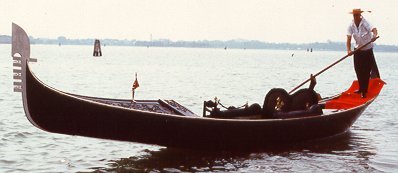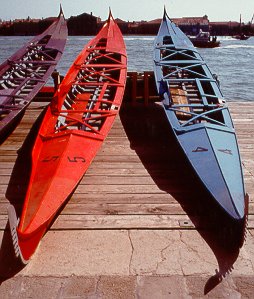GONDOLA
AND SIMILAR BOATS
![]()
The gondola ![]() is the most
well-known boat in the world: even people who have never
been to Venice can immediately recognize its unique
shape, the metal bow decoration (fèro
is the most
well-known boat in the world: even people who have never
been to Venice can immediately recognize its unique
shape, the metal bow decoration (fèro ![]() ) and for the
distinctive Venetian
rowing style (voga alla
veneziana).
) and for the
distinctive Venetian
rowing style (voga alla
veneziana).
 Like all
the other
lagoon boats the gondola has a
flat bottom which allows it to float in very shallow
water. The most important characteristic of the gondola
is its longitudinal asymmetry: the keel is not straight
but curves towards the right so that the gondola lists to
the right. This counterbalances the push of the single
oar which would tend to direct the boat to the left.
Like all
the other
lagoon boats the gondola has a
flat bottom which allows it to float in very shallow
water. The most important characteristic of the gondola
is its longitudinal asymmetry: the keel is not straight
but curves towards the right so that the gondola lists to
the right. This counterbalances the push of the single
oar which would tend to direct the boat to the left.
But how was the gondola ‘born’? There was no
inventor nor designer: the boat that we see gliding in
the Venetian canals was developed through the centuries
with gradual and imperceptible variations.
Some curious facts: the gondola weighs about 400 kg, is
built using eight different types of wood; the degree of
curvature is based on the weight of the gondolier.
Before being used exclusively for tourism, the gondola
made use of a removable cabin called a felse for
use in the winter or during the night. It came with a
door and sliding windows with Venetian blinds and curtains, a mirror and a charcoal
burner. The felse
was used to protect the passengers from the cold and from
prying eyes.
Various other boats belong to the gondola family, these
include:
 -
The Gondolino da regata: a fast
boat which is difficult to row, it is used exclusively in
the Historic Regatta (Regata Storica). The gondolino made
its first appearance (in its modern form) in 1825.
-
The Gondolino da regata: a fast
boat which is difficult to row, it is used exclusively in
the Historic Regatta (Regata Storica). The gondolino made
its first appearance (in its modern form) in 1825.
The shape of the gondolino is based on that of the
gondola, and its current measurements are: overall length
10.5 m, overall width 1.1 m, keel width 0.65 m, height at
mid-length 0.36 m, weight approx. 160 kg. ![]()
- Barchéta a cóa de
gàmbaro: a particular type of gondola with
the bow stem stretched forwards and upper sides flared
outwards. Instead of the normal metal bow decoration (fèro)
it had a downward-pointing metal curl.
The only example of a boat of this kind can be seen at
the Maritime Museum (Museo Storico Navale) in Venice.
- Barchèta a massòche:
a variation of the classic gondola of which there is only
one example conserved at the Museo Storico Navale in
Venice. It was less slender and less asymmetrical than
the better-known gondola, and was used to transport
passengers across the lagoon, for postal services,
hospitals, funerals, prisons, etc. It was called the barchèta
a massòche (massòche means mallet) due to
the shape of its extremities. It was also called barchèta
da paràda, gondola lagunar, barchéta
da fresco.
Now barchèta a massòche refers to the gondola
ferries which cross the Grand Canal.
- Mussìn: boat for two or four oars which was very light, similar to the gondolino but with the bow boom inclined forwards without the metal decoration (fèro). Until a few years ago, it was used as the leading boat in the Regata Storica.
- Disdotona: boat for processions with eighteen (disdòto in Venetian dialect) oarsmen from which it derives its name. The first disdotona was built in 1903, the type used today in 1973. It is 18 m long and can be taken apart into three sections for ease of storage and transport.